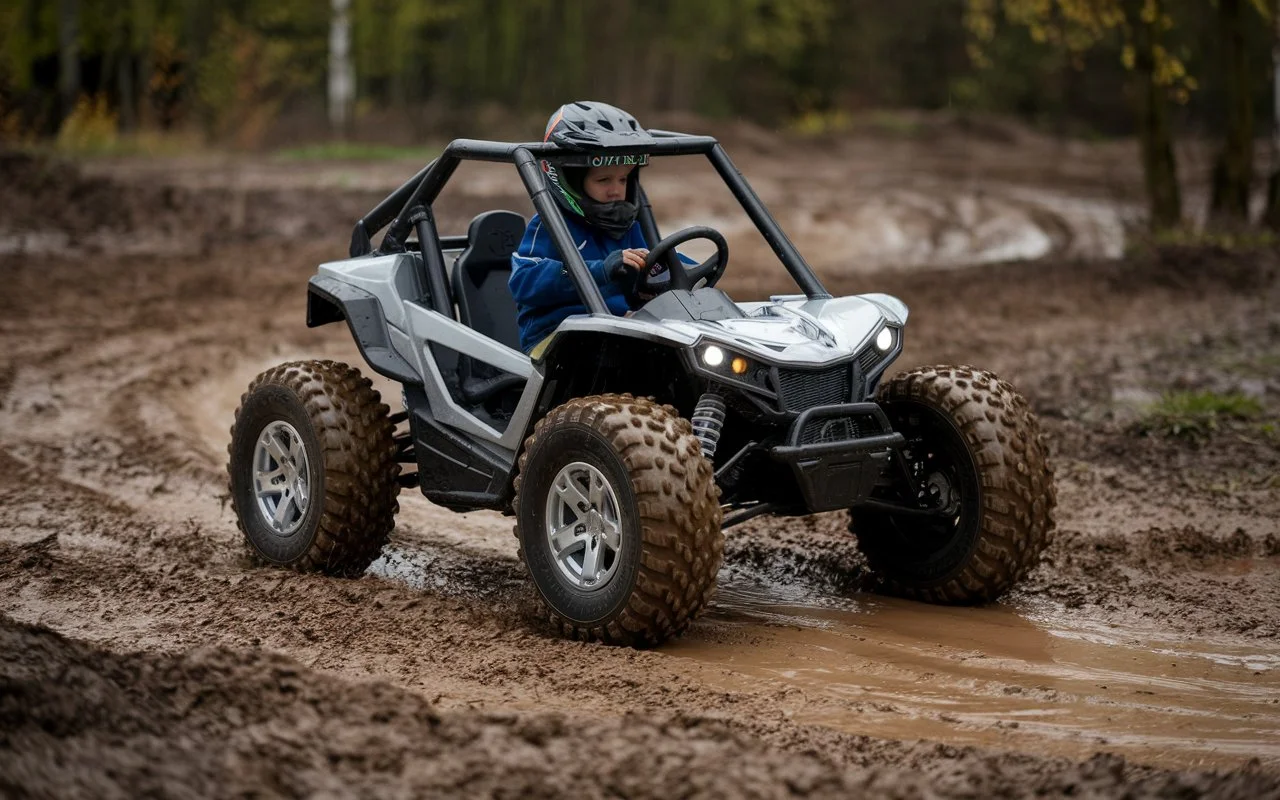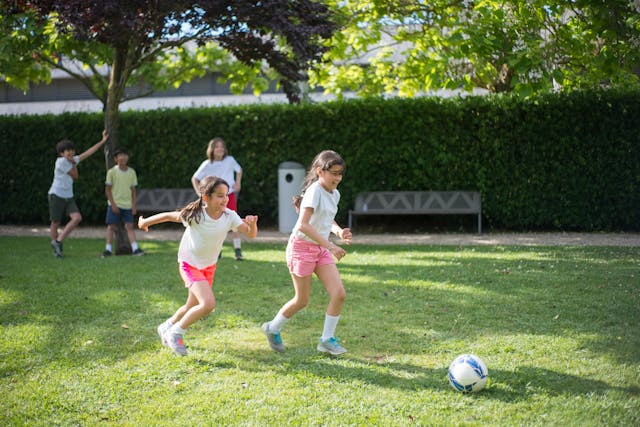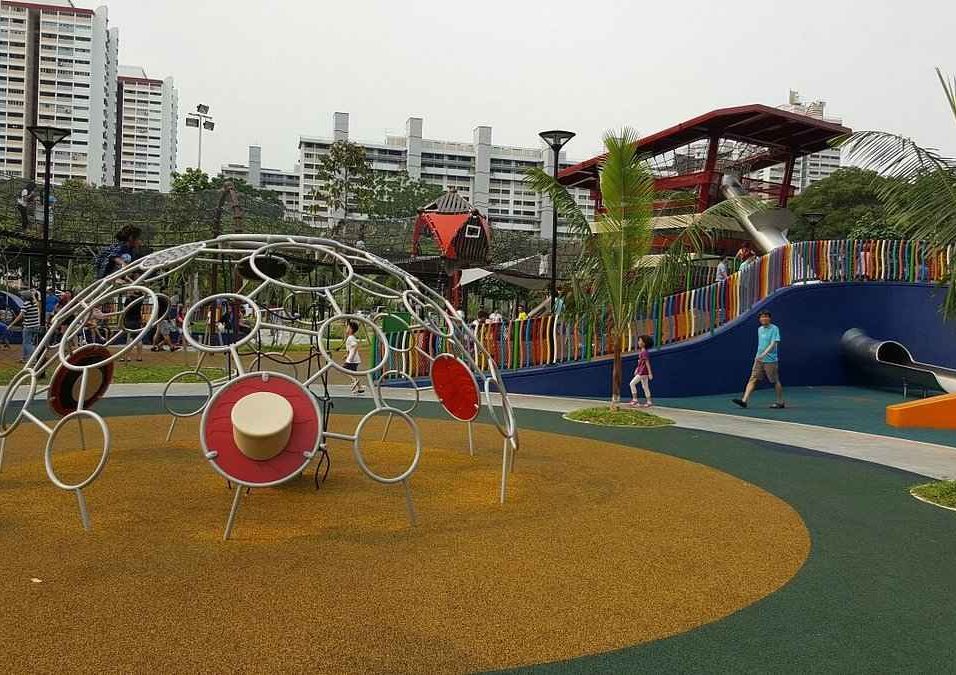Kids Ride-On Cars- Performance in Wet or Muddy Conditions
Ride-on cars are fun toys for children. They provide a safe and enjoyable way to drive. These cars are made for kids aged 3 to 8. They look like real cars but use electric motors to move. Most have a 6V or 12V battery, which lasts about 1 to 2 hours when fully charged. They usually go at speeds of 2 to 5 mph. This makes them safe for kids while still being exciting.
Safety features are very important. Common features include seat belts, a remote that parents can use, and automatic brakes. The size and weight limit can differ. A typical ride-on car is around 50 inches long and 30 inches wide. It can hold up to 100 pounds.
Ride-on cars are strong, but they are not good for wet or muddy places. Victoria Finkel, who owns KidsVIP, says that the electrical parts can react badly to moisture. This can lead to rust or short-circuits. So, when you take these cars outside, it’s best to pick dry grass or asphalt. This helps keep them working well, especially in tough weather.
Pros and Cons of Ride-On Cars:
Pros:
- Motor Skills Development: Steering, accelerating, and braking on ride-on cars help kids develop hand-eye coordination and fine motor skills.
- Physical Exercise: Encourages physical activity as kids engage muscles for balance and movement.
- Independence & Confidence: Operating their own vehicle gives children a sense of independence, boosting self-confidence.
- Imaginative Play: Kids can role-play, pretending to drive to various locations, which nurtures creativity.
- Social Interaction: Kids can enjoy ride-on cars with friends or siblings, promoting social skills and cooperation.
Cons:
- Costly: Quality ride-on cars can be expensive, especially those with advanced features like remote control.
- Safety Concerns: Risk of falls or minor injuries; supervision is essential, especially in busy or uneven areas.
- Space Requirement: Ride-on cars need space for safe use, making them difficult to use in smaller yards or homes.
- Maintenance: Battery-powered models need regular charging, and tires may need replacement over time.
- Limited Skill Development: While beneficial, ride-on cars may offer fewer motor skill benefits compared to manual outdoor activities like bikes or scooters.
Educational Benefits of Outdoor Play with Ride-On Cars:
- Enhances Spatial Awareness: Navigating obstacles teaches kids spatial awareness and direction, helping them understand physical boundaries and distances.
- Builds Problem-Solving Skills: Kids learn to maneuver around obstacles, fostering problem-solving abilities and critical thinking.
- Encourages Responsibility: Taking care of their ride-on car, such as charging or cleaning, teaches kids responsibility.
- Supports Sensory Development: Outdoors, children experience various sights, sounds, and textures, enriching their sensory experience.
- Promotes Teamwork and Sharing: When playing with others, kids learn to share their ride-on car and take turns, reinforcing cooperation and patience.
Ride-on cars provide a fun, interactive way for kids to develop valuable skills, bridging physical activity with learning opportunities for overall growth.
Design And Features Relevant To Wet Conditions:
Electric ride-on cars do not work well in wet or muddy areas. This affects how fun they are and how well they function.
Waterproof Materials
These cars do not have waterproof materials; they only have parts that can resist water. The plastic on the outside can handle light splashes, but the electrical parts inside, like the 12V battery, are very sensitive to water damage. If they get wet, you may face problems like short circuits and rust. To keep the car safe from rain or snow, use a good waterproof cover and try to store the battery inside when you can.
Tyre Traction And Grip
When driving in wet places, there is usually less grip. Ride-on cars usually have smooth plastic tyres, which do not work well in muddy areas. This can lead to sliding and less control. If the car slips in wet weather, kids could be in danger. Changing the tyres to rubber or ones with treads can improve grip, but these cars are mainly made for dry ground. Experts like Victoria Finkel, who owns Kidsvip, stress the need to know these limits.
Performance In Wet Conditions:
Ride-on cars do not work well in wet or muddy places because they are sensitive to moisture. Their plastic bodies can handle some rain, but the electrical parts inside can get damaged.
Handling And Maneuverability
In wet or muddy conditions, ride-on cars have trouble with handling and manoeuvring. Wet surfaces make it hard for tyres to grip the ground. Usually, the smooth plastic tyres on these cars do not provide good traction. In places like grass or gravel, losing traction can cause skidding. For instance, switching to rubber or treaded tyres might help a little, but these cars are not made for those types of ground.
Battery Life And Efficiency
Wet conditions can greatly affect how long ride-on car batteries last. Water can get inside the batteries and cause short-circuits. This leads to a quick loss of power. Normally, 6V and 12V batteries run for about 1 to 2 hours in good conditions. But, if they get wet, this time can go down a lot. It is important to keep batteries in dry places to avoid damage and keep them working well.
Performance In Muddy Conditions:
Ride-on cars have big challenges in muddy conditions. This can impact how well they work and the fun your child has using them.
Stability and Control
Stability is affected when ride-on cars go over muddy areas. A common problem is losing grip, especially with plastic tyres that do not hold well. This can cause skidding and trouble steering. Rubber or treaded tyres also find it hard to keep steady on slippery ground. It is important to avoid staying in muddy conditions for long to help the vehicle last longer. Victoria Finkel, owner of Kidsvip, talks about how important it is to know these limits in ride-on car performance.
Maintenance Challenges
Mud creates several challenges for keeping things in good shape. It can build up in wheels and mechanical parts, which may cause damage over time. Water and dirt getting into the electrical system can cause short circuits because the internal electronics are not made to handle mud. Cleaning often is very important to avoid these problems. It is best to choose dry conditions to lower these maintenance issues.
Safety Considerations
Ride-on cars do not work well in wet and muddy conditions. This can damage their electrical parts and reduce safety. These cars are fun for young drivers, but we need to know their limits in tough situations.
Risk Of Skidding Or Sliding
In wet and muddy conditions, ride-on cars are more likely to skid or slide. The smooth plastic tires on many models do not grip slippery surfaces well. This can lead to a higher chance of losing control. When driving on grass or gravel, less grip can result in unsafe skidding. Even better rubber or patterned tires have a hard time in these situations. This shows why we should keep these vehicles away from wet areas.
Precautions For Wet And Muddy Use
Avoiding wet places helps your ride-on car work better and last longer. If you can’t avoid getting it wet, use a waterproof cover. It’s also good to store the car in a dry place. The part with the battery can easily get wet. Taking it out and keeping it indoors can stop water damage. Victoria Finkel, who owns Kidsvip, suggests cleaning the wheels and moving parts often to get rid of mud and dirt. Cleaning and storing your car safely can make it last longer and be more fun to use.
Real Parent Tips for Using Ride-On Cars:
- Prioritize Safety Gear: Even on smooth surfaces, helmets and elbow/knee pads add an extra layer of protection. Supervise kids, especially younger ones, to avoid accidents.
- Start on Flat, Open Surfaces: Begin in safe, open spaces like driveways or parks to let kids learn to steer and maneuver before tackling any inclines or obstacles.
- Keep Batteries Charged: Avoid mid-ride meltdowns by charging the car after each use or the night before; a fully charged battery ensures a smooth and uninterrupted playtime.
- Set Speed Limits: Many ride-on cars have speed settings—start with the lowest to help kids gain control and confidence, then gradually increase as they get more comfortable.
- Establish Play Rules: Teach kids boundaries like avoiding streets or steep areas and the importance of parking safely when they’re done to instill responsible play habits.
User Experiences And Testimonials:
Ride-on car owners often face problems when driving in wet or muddy areas. Many users say they experience hydroplaning at speeds of just 2 mph, mostly due to smooth plastic tires. This leads to slipping on wet grass or gravel. Parents find that switching to rubber tires improves grip and helps reduce these problems.
One customer reported less battery life when the car is in moisture. The usual 6V or 12V batteries last about 90 minutes in dry conditions. However, this time can drop by 30% in wet weather. Keeping the battery in good shape is important. Regular cleaning and storing it dry can help prevent problems.
Victoria Finkel, the owner of Kidsvip, points out how important it is to know these limits. She advises people to only use ride-on cars on dry surfaces. Her advice has helped many parents make their cars last longer. Feedback shows that users should use waterproof covers if it might rain. Still, most people like sunny days to keep from having problems with handling and electrical issues.
Users who go into muddy spots often find mud stuck around the wheels. This makes performance go down. Many users say that cleaning it often helps keep it working well. Checking and cleaning your ride-on regularly helps you get the most from its battery and motor without adding extra damage.









